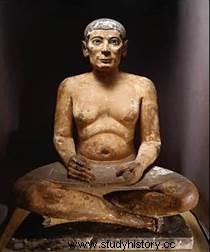 Egypt ancient is one of the oldest civilizations of antiquity. A little before 3000 BC, King Narmer united Upper and Lower Egypt into a single country. He is the first pharaoh of a long line of sovereigns who will reign for more than 2,500 years. The country of the pharaohs owes its prosperity and its exceptional longevity to the Nile, which brought regular annual floods, ensuring ever more abundant harvests. Main axis of north-south communication, the river was bordered by an immense desert which protected the region from invasions and offered building stones and precious metals. Without the Nile, Egypt would therefore only be a desert, and the Egyptian civilization would probably not have been able to arise. As the Greek writer Herodotus pointed out as early as the 5th century BC, “Egypt is a gift from the Nile”.
Egypt ancient is one of the oldest civilizations of antiquity. A little before 3000 BC, King Narmer united Upper and Lower Egypt into a single country. He is the first pharaoh of a long line of sovereigns who will reign for more than 2,500 years. The country of the pharaohs owes its prosperity and its exceptional longevity to the Nile, which brought regular annual floods, ensuring ever more abundant harvests. Main axis of north-south communication, the river was bordered by an immense desert which protected the region from invasions and offered building stones and precious metals. Without the Nile, Egypt would therefore only be a desert, and the Egyptian civilization would probably not have been able to arise. As the Greek writer Herodotus pointed out as early as the 5th century BC, “Egypt is a gift from the Nile”.
Ancient Egypt, a gift of the Nile
From the first cataract, marking the southern border of ancient Egypt, to the Mediterranean, the Nile Valley stretches for 800 kilometers. The Nile has its source at the southern tip of Egypt, in the highlands of East Africa. The torrential rains that fall on this region at the beginning of summer swell the waters of the river until they overflow into Egypt at the end of the summer season. As the floods recede, they leave damp, silt-covered land. There was no need for the Egyptians to erect flood defenses or build irrigation networks. After sowing in the fall, in fertile, waterlogged soil, all they had to do was let the crops ripen under the warm winter sun to harvest the fields in the spring, just before the next flood. Famine affected the population only when unfortunately the floods of the Nile failed.
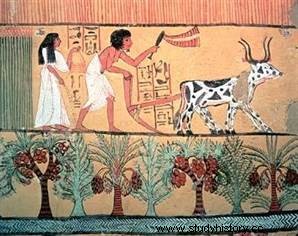
In the Nile Valley, agriculture appeared around the sixth millennium BC. At that time, North Africa was wetter than today:the Sahara, a vast expanse of grasslands dotted with large lakes, was cultivable. Around 4000 BC the climate became drier and the region became desert. Some farmers then adopted a life of nomadic herders, others migrated to the Nile Valley, which was soon to be densely populated.
At the origins of Egyptian civilization
Even before the history of ancient Egypt began, the inhabitants of the Nile valley distinguished two regions:Upper Egypt, in the south, along the river , and Lower Egypt, to the north, around its delta. Both regions have their patron god (the vulture goddess Nekhbet in the south and the cobra goddess Wadjet in the north) and their symbols (the lotus and the white crown in the south, the papyrus and the red crown in the north).
Shortly before 3000 BC, a kingdom emerged in the southern region of Upper Egypt. The pictographic writing system of hieroglyphs was then in use. Historically the first Egyptian king was Narmer, who was credited with the victory over Lower Egypt and the unification of the country. He established his royal capital at Memphis at a strategic point in the center of the new state. Under the reign of the sovereigns who succeeded him, Egypt acquired a powerful governmental system. The king's power rested on his divine nature:he was considered the son of Ra, the sun-god, which gave him immortality.
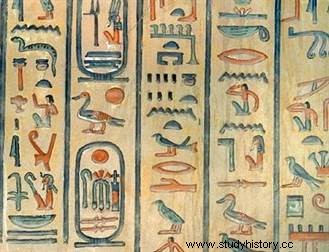 From the texts that have come down to us, historians have been able to draw up a detailed list of the royal dynasties that controlled ancient Egypt, and the approximate dates of their reigns, over a period extending almost continuously from 2920 to 30 BC. They thus divided the history of Egypt into distinct eras. The first dynasties (2920-2649 BC) were followed by the old empire (2649-2134 BC), during which the monarchical power extended its influence southward to Nubia. Then came a period of unrest which saw rival dynasties clash (first intermediate period 2134-2040 BC), before the country was again unified under the Middle Kingdom (2040-1640 BC). J.-C.).
From the texts that have come down to us, historians have been able to draw up a detailed list of the royal dynasties that controlled ancient Egypt, and the approximate dates of their reigns, over a period extending almost continuously from 2920 to 30 BC. They thus divided the history of Egypt into distinct eras. The first dynasties (2920-2649 BC) were followed by the old empire (2649-2134 BC), during which the monarchical power extended its influence southward to Nubia. Then came a period of unrest which saw rival dynasties clash (first intermediate period 2134-2040 BC), before the country was again unified under the Middle Kingdom (2040-1640 BC). J.-C.).
The pharaoh, a god-king
The word "pharaoh" refers to the rulers of ancient Egypt. The pharaoh has a dual nature:he is both a king-man and the son of the sun god Re. The pharaoh is considered by the Egyptians as the embodiment of the gods who placed him on Earth to serve as their intermediary with men. If the Egyptians recognize magical powers in him, such as managing the floods of the Nile, the pharaoh only becomes a god after his death.
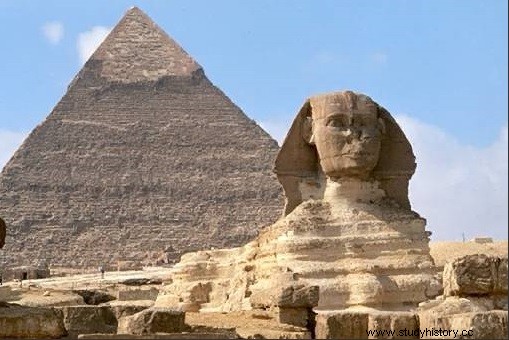 During his reign, the pharaoh was endowed with unlimited powers:he was both the political leader, the chief armies and the religious leader. In his work he is aided by a powerful administration whose most important figures are the viziers. The pharaoh therefore has absolute and highly centralized power.
During his reign, the pharaoh was endowed with unlimited powers:he was both the political leader, the chief armies and the religious leader. In his work he is aided by a powerful administration whose most important figures are the viziers. The pharaoh therefore has absolute and highly centralized power.
The various powers of the pharaoh are symbolized by his attributes. He wears the pschent (the double crown of Upper Egypt and Lower Egypt), which indicates that he dominates the whole country. On his forehead stands the uraeus, the protective cobra. In his hands, the sovereign brandishes two scepters (the hook and the whip), emblems of his royalty.
Throughout the history of ancient Egypt, 31 dynasties of pharaohs succeeded each other on the Egyptian throne until the country was conquered by Alexander the Great in 332 BC (because subsequent rulers, i.e. the Macedonian and Ptolemaic dynasties, were not actually pharaohs).
The Old Kingdom
Around 2649 BC. BC begins the period called Old Kingdom. It was during this period that the Egyptian monarchy and civilization would take on their definitive character. The Old Empire saw the affirmation of values that never ceased to be references for the following centuries, even millennia.
The whole system of pharaonic Egypt was based on the conception of divine kingship. Incarnation of Horus and son of Osiris, the king is the interpreter and agent of the vital force that animates the world. Absolute master of men and things, he alone directs the administration and all economic activity. The whole Egyptian land belongs to him. The peasants, considered as dependents, compelled to do corvées, worked in family teams under the supervision of royal officials. Centralized, bureaucratic, the monarchy of the Old Empire was not arbitrary. From the beginning, the idea of power was not separated from the notion of justice.
Originally, the king alone achieves immortality. Upon his death, he is assimilated to the god Osiris and continues to protect his home and his subjects on earth. This is why the construction of tombs capable of defying the centuries and preserving the immortality of the king constitutes the essential work of the Egyptian reigns. From the reign of Snefrou (circa 2625/2601), the Egyptians led military expeditions against the Nubians, the Libyans or the nomads of Sinai in order to secure the raw materials necessary for their major works, such as wood from Lebanon. .
The builders of pyramids
 The Old Kingdom is marked by the appearance of colossal architecture. King Djoser had Imhotep as his minister, who built, for the first time in Saqqara, a royal tomb raised to the sky by seven rows of stones forming as many landings. This monumental tomb has the function of preserving the immortality of the king who, after his earthly life, continues to protect his people.
The Old Kingdom is marked by the appearance of colossal architecture. King Djoser had Imhotep as his minister, who built, for the first time in Saqqara, a royal tomb raised to the sky by seven rows of stones forming as many landings. This monumental tomb has the function of preserving the immortality of the king who, after his earthly life, continues to protect his people.
The names of Cheops, Chephren and Mykerinos thus reached us through the great pyramids of Giza. The shape of the pyramids evokes the oblique rays of the sun, allowing the deceased king to access paradise. The construction of these gigantic stone structures required considerable labor mobilized for several decades.
When the pharaoh died, his body was mummified. Appearing in the 3rd millennium BC, the process of mummifying the dead in ancient Egypt limits the putrefaction of the body by drying it out. The bandage almost gives the corpse the appearance of life. Thus preserved, the body was to provide the soul with eternal shelter. The remains of the pharaoh were carried to the burial chamber located in the center of the pyramid. Texts and magic formulas adorned the walls of the room filled with sumptuous objects intended to accompany the deceased in the afterlife. After the funeral, the passage leading to the chamber was sealed with stone blocks.
Contrary to popular belief, the pyramids were not built by slaves but by skilled craftsmen, helped by idle peasants during the flood season. No one knows exactly how the thousands of heavy blocks of stone were hoisted on top of each other. The construction of a pyramid requiring considerable means, this practice ceased at the end of the Middle Kingdom. The following sovereigns preferred to testify to their wealth and power by building temples decorated with sculptures and monumental bas-reliefs.
The Middle Kingdom
The Seventh Dynasty marks the beginning of a first intermediate period, which will last from around 2152 to 2065 BC. J.-C. Subjected to foreign raids, the territory is fragmented and famine appears while revolts multiply, coinciding with the spread of the cult of Osiris which seems to testify to a popular aspiration to immortality. After a long period of civil wars, Mentuhotep II succeeded in reunifying Egypt from Thebes, around 2050/2040 BC. The Middle Kingdom (2050/1786) was marked by the restoration of central authority and the establishment of a more flexible administration than that of the Old Kingdom.
 The desire to strengthen national unity was expressed during this period by the religious compromise made with the Theban and Heliopolitan clergy, by which Amun is associated with Ra. The power of the clergy of Amun was to be reinforced throughout the second millennium. The kings of the XIIth Dynasty, Amenemhat I (1991/1962) and Sesostris III (1877/1843), gradually eliminated the provincial powers.
The desire to strengthen national unity was expressed during this period by the religious compromise made with the Theban and Heliopolitan clergy, by which Amun is associated with Ra. The power of the clergy of Amun was to be reinforced throughout the second millennium. The kings of the XIIth Dynasty, Amenemhat I (1991/1962) and Sesostris III (1877/1843), gradually eliminated the provincial powers.
Intercessor between Amon-Ra and men, the pharaoh strengthened his power by lowering that of provincial feudalism and ensuring, during his lifetime, the succession to the throne. At the same time, immortality is becoming more democratic. Everyone can now access it, within the limits imposed by a very strict ritual. This period saw the peak of the influence of the scribes, who then constituted, between the people and the dignitaries, a real “middle class”.
The Middle Kingdom was no more "imperialist" than its predecessor, but its kings wanted to ensure the security of the country by fortifying the outposts of Egypt :to the northeast, where Amenemhat I had the "Prince's wall" built facing the Bedouins (circa 1976); to the south, where the upper Nile valley was annexed as far as Semma, beyond the second cataract, on the borders of Nubia, and protected by the construction, under the XIIth dynasty, of fourteen fortresses which range from Elephantine at Semna. In the heart of Egypt, Amenemhat III (1842/1797) ordered major draining and irrigation works for the development of the Fayoum, where he built a huge funerary complex, the “labyrinth” of the Greeks.
Invasions and rebirth
Ancient Egypt, which had lived in peace and prosperity for about three centuries, entered an unstable period, known as the second intermediate period (1640-1532 BC). VS.). Egyptian unity was shaken by the influx of Semitic populations from Asia driven out by the Indo-European invasions. Thus the Hyksos, established in the northeast of the Delta, take advantage of the weakening of the power of the pharaohs of the XIIIth and XIVth dynasties to conquer all of Lower Egypt. They mastered the art of war, brought horses and chariots to Egypt. A second intermediate period opens when Avaris, the center of power of the Hyksos, becomes the capital of a fifteenth foreign dynasty. The Hyksos kings adopted Egyptian customs, worshiped the Egyptian gods Seth and Ra, and took the cartouche and protocol of the pharaohs of Egypt.
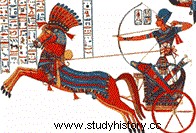 The south, however, resisted the conquerors. The princes of Thebes, who control the territory between Elephantine and Abydos, undertake to liberate the territory. Kamosis manages to defeat the Hyksos, but it is his brother, Pharaoh Amosis I, who ultimately drives them out and reunites the country. He is the real founder of the XVIIIth dynasty and of the New Empire (around 1552/1070). Ahmose was the founder of the Eighteenth Dynasty and the New Kingdom (circa 1552/1070). It was at this time that the term pharaoh appeared. This title, which means "great palace", symbolized their position at the center of government.
The south, however, resisted the conquerors. The princes of Thebes, who control the territory between Elephantine and Abydos, undertake to liberate the territory. Kamosis manages to defeat the Hyksos, but it is his brother, Pharaoh Amosis I, who ultimately drives them out and reunites the country. He is the real founder of the XVIIIth dynasty and of the New Empire (around 1552/1070). Ahmose was the founder of the Eighteenth Dynasty and the New Kingdom (circa 1552/1070). It was at this time that the term pharaoh appeared. This title, which means "great palace", symbolized their position at the center of government.
The foreign occupation they had just suffered had made the Egyptians understand that the time of Isolation which their country had enjoyed until the arrival of of the Hyksos. By strengthening its army, Egypt engaged for four centuries in a series of interminable wars whose stake was the control of the Syrian-Palestinian coasts, the caravan routes leading to Mesopotamia and maritime trade in the eastern Mediterranean. Unlike the Old and Middle Kingdoms, the New Kingdom was resolutely imperialist; he disputed the mastery of the East with the two other great powers of this period, Mitanni and the Hittites, but his efforts never led to a definitive result.
The New Kingdom:the golden age of ancient Egypt
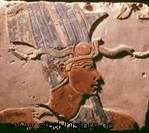
Both outside and inside, both through the conquests and through the luxury of court life and the flourishing of letters and the arts (necropolis of the Valley of the Kings), the XVIIIth dynasty (circa 1570-1319) marked the apogee of ancient Egypt. From the reign of Amenhotep I (1546-1524), the troops of the pharaoh submerged Syria and reached the Euphrates; but these first results were quickly canceled by local revolts and by a dynastic crisis in Egypt (usurpation of Queen Hatshepsut, 1503-1482).
The whole work of conquest in Asia had to be started again by Thutmose III (1482/1450). During his personal reign, this pharaoh, the most glorious in Egyptian history, led no less than eighteen Asian campaigns. Winner, in Megiddo, of a powerful Syrian-Palestinian coalition inspired by Mitanni (1482), he then seized Kadesh on the Orontes (1474) and completed the conquest of Syria by reaching the Euphrates again ( 1472).
To the south, Nubia, already annexed to the Middle Kingdom, was reoccupied by Ahmose from the beginning of the XVIIIth dynasty. Thutmose II and Thutmose III launched their expeditions into the heart of the land of Kush and brought the southern border of Egypt to the 4th cataract (before 1477). The organization of the New Kingdom was characterized by great regional diversity. Ancient Egypt proper was subject to a centralized and socialized system; the middle class of scribes and well-to-do peasants had disappeared with the invasion of the Hyksos; henceforth, the central power relied on a body of civil servants much less numerous than formerly, but hereditary.
In conquered countries, imperial authority was not tyrannical. If Nubia, placed under the authority of a viceroy, was quickly and profoundly Egyptianized, in Asia, on the contrary, the pharaohs were content with a flexible regime of protectorates and alliances which left the local princes in place, respected indigenous customs, languages, religions. Egyptian suzerainty was affirmed in the form of financial obligations (annual payment of a tribute in kind:slaves, ore, horses, war chariots, cattle, wood, oil, etc.), economic (commercial treaties ensuring the Egypt the rank of favored nation) and military (each subjugated people had to provide a contingent which served on the spot, under the command of Egyptian officers).
From the Amarna parenthesis to the reign of the Ramesids
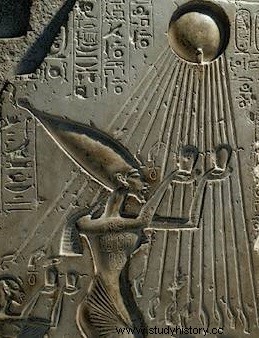 The reign of Amenophis III (circa 1417/1379) saw the flowering of "Egyptian peace" in prosperity, luxury, an unprecedented sweetness of life. However, since the beginning of the New Kingdom, the clergy of Thebes had not ceased to extend their influence and their landed domains; the high priest of Amun had become in a way the second personage of the State.
The reign of Amenophis III (circa 1417/1379) saw the flowering of "Egyptian peace" in prosperity, luxury, an unprecedented sweetness of life. However, since the beginning of the New Kingdom, the clergy of Thebes had not ceased to extend their influence and their landed domains; the high priest of Amun had become in a way the second personage of the State.
It is to react against this interference, perhaps also to permanently base pharaonic imperialism on a religion more widely open to men of all countries than Amenophis IV (1379 -1362) decided to abandon the cult of Amon, god of his dynasty, to establish the purified religion of Aten, the solar disk. Taking himself the name Akhenaten (“Splendour of Aten”), the king and his wife Nefertiti left Thebes and founded a new capital, Akhetaten.
This revolution came up against fierce resistance from Egyptian particularism, embodied by the Theban clergy. ToutAnkhAmon (1361-1352), son-in-law and successor of Amenophis IV, had to quickly reconcile with the priests of Amun, return to Thebes and restore traditions. The crisis left the Egyptian monarchy weakened externally (by about 1375 the Hittites had supplanted the Egyptians in Syria) and discredited internally. A few confused years followed the death of the young ToutAnkhAmon, but General Horemheb seized power (1348-1320) and pursued the reorganization of the state on the basis of the strictest traditionalism, with the support of the Theban clergy, who was more powerful than ever. With the 19th dynasty (1319/1200), Egypt tried to re-establish its Asian empire.
 Seti I (circa 1318-1304) reconquered southern Palestine. His son, Ramses II (1304-1238), tried to retake Syria from the Hittites, who were defeated at Kadesh (c. 1300); but the following campaigns remained undecided, and, around 1284, Egyptians and Hittites ended up signing a treaty which divided Syria between them, and which was confirmed by the marriage of Ramses II with a daughter of the Hittite king Hattousil III. The New Kingdom thus definitively renounced the solitary domination of the East, but it ensured forty years of peace during which the classical Egyptian civilization threw its last brilliance (construction of the funerary temple of Abu-Simbel, the hypostyle hall of Karnak).
Seti I (circa 1318-1304) reconquered southern Palestine. His son, Ramses II (1304-1238), tried to retake Syria from the Hittites, who were defeated at Kadesh (c. 1300); but the following campaigns remained undecided, and, around 1284, Egyptians and Hittites ended up signing a treaty which divided Syria between them, and which was confirmed by the marriage of Ramses II with a daughter of the Hittite king Hattousil III. The New Kingdom thus definitively renounced the solitary domination of the East, but it ensured forty years of peace during which the classical Egyptian civilization threw its last brilliance (construction of the funerary temple of Abu-Simbel, the hypostyle hall of Karnak).
Decline of the pharaohs and end of ancient Egypt
The Hittite danger averted, the integrity of the territory must be defended against new invaders:the Peoples of the Sea, who came from the coasts of Asia Minor and Greece, whose they were driven out by new Indo-European invasions and by the arrival of the Dorians in the Aegean Sea. Son and successor of Ramses II, Mineptah (or Merenptah) repels them.
It was at this time that the Jews, persecuted by the pharaoh, left the country and reached the Promised Land, led by Moses. After the death of Ramses III, the second ruler of the 20th Dynasty, the decline of the New Kingdom begins. The state, ruined and beset by the Assyrians and Libyans, fell under the domination of the clergy of Amun, including the high priest Herihor, who seized power in Upper Egypt.
 Despite some upheavals during the reigns of Pharaohs Chechonq I (945-924 BC) and Psammetichus I (664 -610 BC), Egypt no longer had the means to resist the incessant invasions. Ruined, the last pharaohs no longer even had the necessary means to build their tomb. Egypt was then dominated in turn by Nubians, Assyrians and Persians, before submitting to the troops of Alexander the Great in 332 BC. A dynasty of Greek origin settled on the throne of the pharaohs:the Ptolemies.
Despite some upheavals during the reigns of Pharaohs Chechonq I (945-924 BC) and Psammetichus I (664 -610 BC), Egypt no longer had the means to resist the incessant invasions. Ruined, the last pharaohs no longer even had the necessary means to build their tomb. Egypt was then dominated in turn by Nubians, Assyrians and Persians, before submitting to the troops of Alexander the Great in 332 BC. A dynasty of Greek origin settled on the throne of the pharaohs:the Ptolemies.
Up to the 2nd century BC. J.-C., Ptolemaic Egypt is a rich and powerful empire, whose capital, Alexandria, constitutes an exceptional commercial and intellectual center. Then the internal quarrels, the frequent popular revolts and the wars against the empire of the Seleucids weaken the empire of the Lagides. The power of the Lagide dynasty declined under a succession of weak kings in the 2nd and 1st centuries BC. BC, when Rome began to intervene more and more in the affairs of the country.
The last and probably the most famous of the Ptolemaic rulers was Cleopatra, who ruled independently at first, with the support of Julius Caesar and then Mark Antony. With his death and that of his son, Ptolemy XIV said Caesarion in 30 BC. AD, the dynasty died out and Egypt was annexed to the Roman Empire by Augustus. The oldest ancient civilization then leaves behind a fabulous cultural and artistic heritage, which will be admired by future generations.
Bibliography
- History of Ancient Egypt by Nicolas Grimal. Fayard, 1988.
- In the kingdom of Egypt:the time of the god-kings by Claire Lalouette. Flammarion 1997.
- Egypt:Stories of Herodotus. The beautiful letters, 2002.
- Historical Dictionary of Ancient Egypt, by Philippe Chatel. Berg, 2001.
